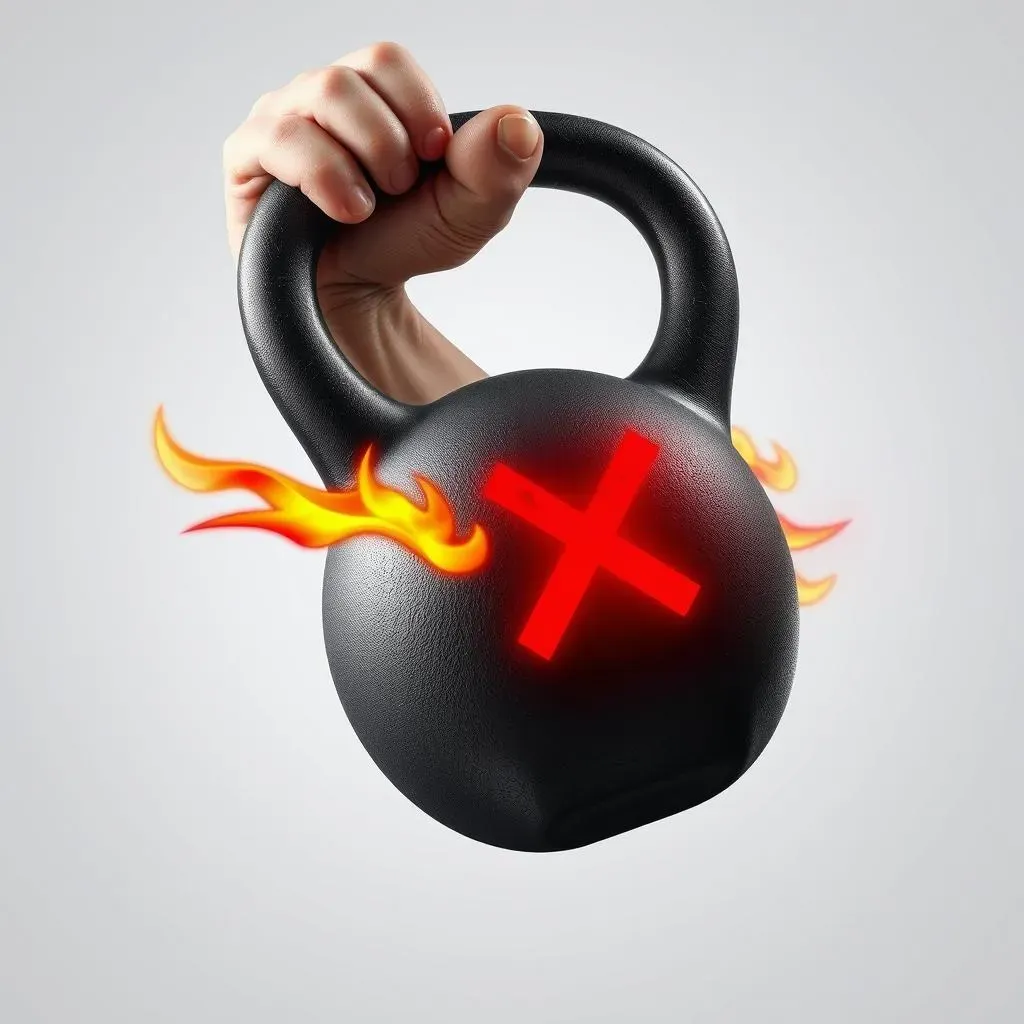Table of Contents
Kettlebells: they're the ultimate tool for building strength, burning fat, and sculpting a physique that screams "I crush my workouts." But let's be real, all that swinging, snatching, and pressing can sometimes lead to a not-so-pleasant side effect: a kettlebell shoulder injury. Shoulder pain can sideline even the most dedicated fitness fanatics. This isn't just about annoying aches; we're talking about potential tears, strains, and impingements that can seriously mess with your training goals. But don't ditch the kettlebell just yet! The good news is that most kettlebell shoulder injuries are totally avoidable with the right knowledge and approach. We will dive into the common mistakes that lead to shoulder pain, from using improper form and selecting the wrong weight to neglecting crucial mobility work. By understanding the risks and implementing smart strategies, you can keep your shoulders healthy and your kettlebell workouts pain-free. Let's unlock the secrets to safe and effective kettlebell training, so you can keep swinging towards your fitness goals without wincing in agony.
Understanding the Risks: Why Kettlebell Shoulder Injuries Happen

Understanding the Risks: Why Kettlebell Shoulder Injuries Happen
#1: The Shoulder Joint: A Complex Player
The shoulder is this incredible ball-and-socket joint, giving us a massive range of motion. Think about it: you can reach overhead, across your body, and behind your back – all thanks to this one joint. But that flexibility comes at a price. Unlike the hip, which is a deep, stable socket, the shoulder socket is shallow. This means it relies heavily on the surrounding muscles, tendons, and ligaments for stability. When those structures aren't strong enough or aren't working together correctly, the shoulder becomes vulnerable to injury.
Now, throw a kettlebell into the mix, and you've got a recipe for potential disaster if you're not careful. Kettlebell exercises often involve dynamic, explosive movements that demand a lot from the shoulder joint. If you're not properly prepared, or if your form is off, you can easily overload the shoulder and cause pain.
#2: Common Culprits: Movement Patterns Gone Wrong
So, what specific movements tend to cause trouble? Overdoing it with overhead movements is a big one. Think about kettlebell snatches, push presses, and windmills. These exercises put the shoulder in a compromised position, especially if you lack the necessary mobility or strength. Another common issue is relying too much on your shoulder muscles during swings. The power for a kettlebell swing should come from your hips and glutes, not your arms and shoulders. If you're feeling it primarily in your shoulders, you're doing it wrong!
Improper technique during Turkish get-ups can also wreak havoc on your shoulders. This exercise requires a high degree of stability and control, and if you rush through it or lack the necessary strength, you can easily strain the shoulder joint. Lastly, not engaging your lats properly during many kettlebell exercises is a common mistake. Strong lats help stabilize the shoulder blade and protect the shoulder joint. If they're not firing correctly, your shoulder is more likely to take a beating.
#3: Underlying Issues: Mobility, Stability, and Weakness
Sometimes, a kettlebell shoulder injury isn't just about one bad rep. It can be the result of underlying issues that have been brewing for a while. Limited shoulder mobility is a huge factor. If you can't move your shoulder through its full range of motion without pain or restriction, you're setting yourself up for trouble. Poor scapular stability is another common problem. The shoulder blade needs to move smoothly and in coordination with the arm. If it's not stable, the shoulder joint is forced to compensate, leading to increased stress and potential injury.
Weakness in the rotator cuff muscles is also a major contributor to shoulder pain. These muscles are responsible for stabilizing the shoulder joint and controlling its movement. If they're weak, the shoulder is more likely to become unstable and prone to injury. Finally, pre-existing conditions like shoulder impingement or rotator cuff tendinitis can make you more susceptible to kettlebell shoulder injuries. If you have a history of shoulder problems, it's essential to work with a qualified healthcare professional before starting a kettlebell program.
Perfecting Your Form: The Key to Avoiding Kettlebell Shoulder Injury

Perfecting Your Form: The Key to Avoiding Kettlebell Shoulder Injury
Mastering the Fundamentals: The Foundation of Safe Kettlebell Training
Alright, so you're ready to swing some iron without trashing your shoulders? Awesome! But before you start slinging kettlebells around like a ninja, let's nail down the basics. Proper form is the single most important factor in preventing kettlebell shoulder injuries. Seriously, it's not about how much weight you can lift; it's about how well you can lift it. Think of it like building a house – you wouldn't start putting up the roof before laying a solid foundation, right? Same goes for kettlebells.
Start with the fundamental movements: the swing, the goblet squat, the deadlift, and the Turkish get-up. These exercises will teach you how to engage your core, hinge at your hips, and maintain a neutral spine – all crucial for protecting your shoulders. Focus on mastering these movements with lighter weights before progressing to heavier loads. And don't be afraid to film yourself! It's amazing what you can catch on video that you don't notice in the moment. Compare your form to videos of experienced kettlebell instructors and see where you can improve.
The Swing: Hip Hinge, Not Shoulder Hike
Let's zoom in on the kettlebell swing because it's often the culprit behind shoulder pain. The biggest mistake people make is turning it into an upper-body exercise. Your shoulders shouldn't be doing all the work! The swing is a hip-hinge movement, meaning the power comes from your glutes and hamstrings. Think of your arms as ropes that are simply guiding the kettlebell. At the top of the swing, squeeze your glutes and brace your core. Your shoulders should be relaxed and pulled back, not shrugged up towards your ears. Imagine you're trying to crack a walnut between your shoulder blades.
Another key point is to maintain a neutral spine throughout the swing. Avoid rounding your back or arching excessively. Keep your core engaged and your gaze forward. If you're struggling to maintain proper form, try practicing the hip hinge without the kettlebell first. Focus on pushing your hips back and keeping your back straight. Once you've mastered the hip hinge, you can gradually add the kettlebell back in. Remember, it's better to use a lighter weight with perfect form than a heavier weight with sloppy technique.
Weight Selection Matters: Choosing the Right Kettlebell to Protect Your Shoulders

Weight Selection Matters: Choosing the Right Kettlebell to Protect Your Shoulders
The Goldilocks Principle: Not Too Heavy, Not Too Light
so you've got the form down, but you're still feeling some twinges in your shoulder? Time to talk weight. Choosing the right kettlebell is crucial for preventing injury. It's not about ego lifting; it's about finding that sweet spot where you can challenge yourself without compromising your form. Too heavy, and your shoulder will be forced to compensate, leading to strain and potential injury. Too light, and you won't be engaging the right muscles or getting the full benefit of the exercise. It's like Goldilocks and the three bears – you need to find the weight that's just right.
Start with a weight that allows you to perform the exercise with perfect form for the recommended number of repetitions. If you're struggling to maintain proper technique, don't be afraid to drop down a size. It's better to start light and gradually increase the weight as you get stronger. Remember, consistency and proper form are key to long-term progress. Don't rush the process; your shoulders will thank you for it!
Exercise | Recommended Weight (Women) | Recommended Weight (Men) |
|---|---|---|
Kettlebell Swing | 8-12 kg | 16-24 kg |
Goblet Squat | 8-12 kg | 12-16 kg |
Turkish Get-Up | 4-8 kg | 8-16 kg |
Progressive Overload: Gradually Increasing the Challenge
Once you've found a weight that feels comfortable, don't get stuck there! To continue making progress, you need to gradually increase the challenge. This is known as progressive overload. There are several ways to do this. You can increase the weight, increase the number of repetitions, or increase the number of sets. You can also try more challenging variations of the exercise.
But remember, progressive overload should be gradual and controlled. Don't jump from an 8 kg kettlebell to a 24 kg kettlebell overnight! Increase the weight in small increments and always prioritize proper form. If you start to feel pain in your shoulder, back off immediately. It's better to take a step back than to risk a serious injury. Listen to your body and be patient. With consistent effort and smart training, you'll be swinging heavier kettlebells in no time!
Mobility and WarmUp: Preparing Your Shoulders for Kettlebell Training

Mobility and WarmUp: Preparing Your Shoulders for Kettlebell Training
Why Mobility Matters: Unlocking Your Shoulder's Potential
Think of your shoulders like a finely tuned race car engine. You wouldn't redline it without warming it up first, right? Same goes for your shoulders before a kettlebell session. Mobility is all about your shoulder's ability to move freely through its full range of motion. Tightness in the surrounding muscles, like the pecs, lats, and traps, can restrict this movement and make your shoulder more susceptible to injury. Kettlebell exercises demand a lot from your shoulders, so ensuring they're mobile and ready to go is non-negotiable.
A good mobility routine will help loosen up those tight muscles, improve joint lubrication, and enhance your overall movement quality. This not only reduces your risk of injury but also allows you to perform kettlebell exercises with better form and more power. It's a win-win!
The Dynamic Warm-Up: Getting Your Shoulders Fired Up
Forget static stretching before your workout! Dynamic warm-ups are the way to go. These involve active movements that gradually increase your heart rate and blood flow to your muscles. Think arm circles, shoulder rotations, and torso twists. These movements help prepare your shoulders for the demands of kettlebell training by improving mobility, stability, and coordination. A dynamic warm-up also helps activate the muscles around your shoulder joint, ensuring they're ready to support and protect it during exercise.
Here's a quick dynamic warm-up routine you can try before your next kettlebell workout:
- Arm circles (forward and backward): 10 reps each direction
- Shoulder rotations: 10 reps each direction
- Torso twists: 10 reps each direction
- Band pull-aparts: 15 reps
- Scapular retractions: 15 reps
Targeted Mobility Drills: Addressing Specific Limitations
Sometimes, a general warm-up isn't enough. If you have specific mobility limitations, you may need to incorporate targeted mobility drills into your routine. For example, if you have tight pecs, you can try doorway stretches or foam rolling your chest muscles. If you have limited shoulder internal rotation, you can try sleeper stretches. The key is to identify your specific limitations and choose mobility drills that address them. Be patient and consistent with your mobility work. It may take time to see results, but the payoff in terms of injury prevention and performance enhancement is well worth the effort.
Listen to Your Body: Recognizing and Responding to Kettlebell Shoulder Pain

Listen to Your Body: Recognizing and Responding to Kettlebell Shoulder Pain
The Whispers vs. The Shouts: Differentiating Discomfort from Injury
Alright, let's get real. You're pushing yourself in your kettlebell workout, and you feel something in your shoulder. Is it just muscle soreness, or is it something more serious? Learning to differentiate between normal discomfort and actual pain is crucial for preventing a minor issue from turning into a major setback. Think of it like this: your body whispers to you before it shouts. It's up to you to listen to those whispers and take action before they escalate into a full-blown scream.
Muscle soreness, also known as delayed onset muscle soreness (DOMS), is a common side effect of exercise, especially when you're trying new movements or increasing the intensity. It typically sets in 24-72 hours after your workout and feels like a general ache or stiffness in the muscles. Pain, on the other hand, is a sharper, more localized sensation that often occurs during or immediately after exercise. It can be accompanied by other symptoms like swelling, tenderness, or limited range of motion. If you're experiencing any of these symptoms, it's a sign that something's not right.
Red Flags: When to Stop and Seek Help
So, how do you know when to stop and seek help? Here are some red flags to watch out for:
- Sharp, stabbing pain in your shoulder
- Pain that radiates down your arm
- Numbness or tingling in your arm or hand
- Significant loss of strength in your shoulder or arm
- Inability to move your shoulder through its full range of motion
- Visible swelling or bruising around your shoulder
If you're experiencing any of these symptoms, stop your workout immediately and consult with a qualified healthcare professional, such as a physical therapist or sports medicine doctor. Don't try to "tough it out" or push through the pain. Doing so could make the injury worse and prolong your recovery.
The RICE Protocol: Initial Steps for Managing Shoulder Pain
If you experience a minor shoulder twinge during your kettlebell workout, the first thing you should do is apply the RICE protocol: Rest, Ice, Compression, and Elevation. Rest your shoulder by avoiding any activities that aggravate the pain. Apply ice to the affected area for 15-20 minutes at a time, several times a day. Use a compression bandage to help reduce swelling. And elevate your arm on a pillow to further minimize swelling and promote healing.
You can also take over-the-counter pain relievers like ibuprofen or naproxen to help manage the pain and inflammation. However, these medications should only be used for short-term relief. If your pain persists for more than a few days, it's important to seek professional medical advice.
Component | Description | Purpose |
|---|---|---|
Rest | Avoid activities that aggravate the pain | Allow the injured tissue to heal |
Ice | Apply ice for 15-20 minutes at a time, several times a day | Reduce pain and inflammation |
Compression | Use a compression bandage to help reduce swelling | Minimize swelling and provide support |
Elevation | Elevate your arm on a pillow | Reduce swelling and promote healing |
Protect Your Shoulders, Maximize Your Gains
Kettlebell training offers incredible benefits, but it demands respect for proper technique and body awareness. By understanding the risks of kettlebell shoulder injury and actively implementing the strategies we've discussed – perfecting your form, choosing the right weight, prioritizing mobility, and listening to your body – you can significantly reduce your risk of pain and injury. Don't let shoulder pain keep you from reaching your fitness goals. Embrace these principles, train smart, and enjoy the power and versatility of kettlebells for years to come. Your shoulders will thank you for it!